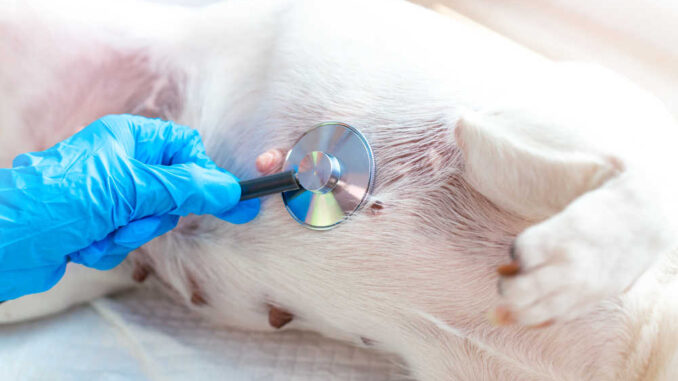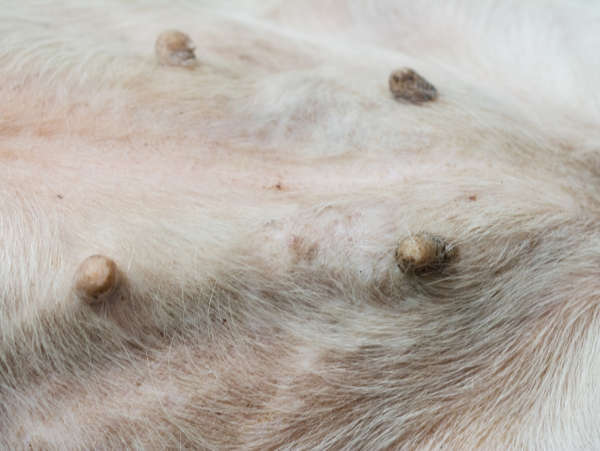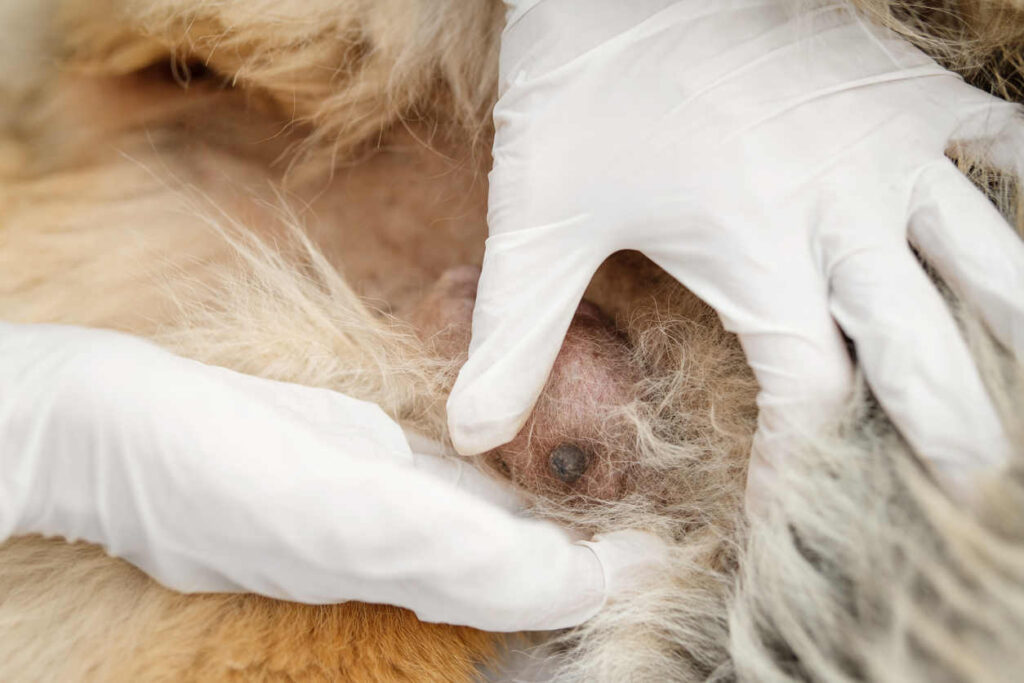
One day, a dog parent called me because he saw what he termed, “a small, dark hole,” on his furbaby’s abdomen in place of the nipple. After asking some questions, I told him it sounded like an inverted nipple and scheduled an office exam to evaluate his pup’s condition.
In this article, I’ll explain what inverted nipples are and the potential causes of the condition. Then, I’ll let you know what to do if you think your dog has an inverted nipple and the signs and symptoms you may observe. To prepare you for a veterinary visit, I’ll go over the diagnosis and treatment options for this condition.
Overview of inverted nipples in dogs
Inverted or retracted nipples can occur in male or female dogs but are most commonly seen in pregnant or nursing bitches. In this condition, one or more nipples turn inward instead of pointing out.
Many times, inverted nipples are merely a cosmetic issue, but sometimes they’re a symptom of a serious health condition. Either way, they can be uncomfortable for your furbaby. If you notice retracted nipples on your dog, talk to your veterinarian.
Causes of inverted nipples in dogs
There are various causes of inverted nipples in dogs. Some are congenital or cosmetic. In other cases, particularly if the nipple is swollen or there are other signs of illness, the retraction can be a symptom of an underlying health condition,
Congenital
This dog pictured here has an inverted nipple (top, left corner of picture). Some dogs are born with inverted nipples. The condition may or may not be inherited from parents. In this case, the nipple will be recessed but not swollen. When inversion is congenital, treatment is not necessary. There’s no cause for panic in this case.
Trauma
This is a picture of an inverted nipple with signs of irritation or inflammation. If your dog suffers an injury or trauma to the chest or abdomen, it may trigger nipple inversion. Usually, the inflammation and possible scar tissue around the nipple(s) contracts and pulls the teat inward.
Signs of traumatic nipple inversion may include:
- Bruising
- Serous discharge or scabbing
- Swelling and inflammation
- Scar tissue
When an injury causes one or more nipples to invert, start by treating the underlying trauma. You can use cool compresses if the injury is recent. Otherwise, apply warm compresses to reduce inflammation in the area. You should also keep the area clean and dry.
As long as the nipple isn’t infected, you probably don’t need to correct the inversion. Consult with your veterinarian to determine the best course of action.
Infection
Pictured here is a dog with mastitis. Notice the discharge and swelling of the glands. An infection of the mammary gland or skin around the nipple may cause nipple inversion. Swelling and inflammation of the surrounding tissues pull on the teat until it turns inward.
Signs of mastitis with nipple inversion include:
- Swelling and redness around the nipple
- Discharge
- Crusting around the nipple
- Pain around the mammary gland/nipple
- Refusal to nurse
- Fever
- Lethargy
If your dog has an inverted nipple with mastitis, gently clean any discharge and crusting from the area and contact your veterinarian. Some forms of mastitis can become toxic and life-threatening. Your veterinarian will flush and treat the nipple and prescribe antibiotics if indicated.
Pregnancy/lactation
This inverted nipple is engorged and leaking milk at the tip.
When female dogs are pregnant and nursing, the mammary glands fill with milk causing physical changes due to hormonal influences. Enlarged glands and nipples can pull on the tissue and cause inversion. Additionally, puppies that nurse aggressively may traumatize the nipples causing them to regress. Nipples that invert usually will correct following weaning.
If your bitch has inverted nipples when she’s nursing a litter, you may need to take action to ensure all the puppies are getting enough milk. Weigh the puppies daily and rotate them on the breast to prevent nipple guarding and aggressive nursing behaviors.
Mammary tumors
Dogs can develop benign or cancerous tumors in the mammary tissue. Although they can occur in males, the condition is most common in intact females. About 50% of the masses will be benign and are usually firm, small nodules.

The rest are cancerous. Signs of mammary cancer include:
- Inverted nipples
- Visible/pronounced, firm lumps or growths in the mammary tissue

- Bleeding or discharge from one or more nipples
- Painful abdomen
- Discoloration
- Lethargy
- Weight loss
When you find firm lumps around your dog’s abdomen and nipples, schedule an exam with your veterinarian. If your dog has cancer, early diagnosis and treatment can significantly improve the prognosis. Treatment for cancerous tumors involves surgical removal of the affected mammary glands and spaying intact females. Chemotherapy or radiation therapy is recommended if the tumor has metastasized to other parts of the body. Learn more about dog mammary tumors and survival rate of dogs with mammary tumors.
What should I do if my dog has inverted nipples?
If your dog has inverted nipples, check for signs of inflammation or an underlying condition. As long as you don’t see other concerning symptoms, there’s no need to panic. Report your observations to your veterinarian.
Many times, the doctor will advise you to monitor your pooch at home. Inverted nipples that appear to be cosmetic in nature can still irritate or become infected. Check the nipple(s) at least once a week for signs of inflammation or irritation.
To care for your pooch at home, clean the nipple(s) regularly. Wipe them weekly with a damp cloth or pet-safe, unscented wipes to remove any dirt. Press down gently on the sides to expose and remove debris. Thoroughly dry the nipples to prevent moisture buildup that can encourage bacterial growth.
Signs and symptoms of inverted nipples in dogs
Nipples tend to invert when the tissue around the teats thickens and exerts inward pressure on the teat. Signs of inverted nipples include:
- Small indentation or dimple in the place of the nipple
- Swelling of tissue around the nipple
- Reddened or discolored skin around the nipple area
- Darkened nipple
- Discharge
- Pain and irritation in the area
- Resistance to/difficulty with nursing
- Lumps or bumps near the inverted nipple(s)
How are inverted nipples in dogs diagnosed?
Inverted nipples are easy to recognize by their appearance. When teats regress, you will notice the tip of the nipple pointing inward. There may be a dimple or flat surface that’s flush with the abdomen. However, if you notice other signs, you should take your dog to the vet to diagnose the underlying cause.
When you take your dog in for an evaluation, the doctor may:
- Examine your dog focusing on the mammary glands and nipples
- Look for signs of trauma or scar tissue
- Take samples of any discharge for a culture
- Take fine needle aspirates of lumps for cytology
- Take x-rays or ultrasounds
When should I seek veterinary help?
Inverted nipples are usually not a problem for dogs. You should notify your veterinarian and monitor the condition when you find them on your furbaby. Seek veterinary help if:
- There’s swelling around the nipple
- You notice a discharge, crust, or bleeding
- The nipple or surrounding tissue looks red
- The area is painful
- You feel or notice lumps in the mammary glands
- Your dog starts losing weight
- Your dog becomes lethargic
What are the treatment options and likely costs?
The treatments for inverted nipples will depend on the underlying cause of the condition.
- Trauma – The cost of an office visit and examination usually ranges from $50-150 depending on your location. Pain medication or anti-inflammatory drugs will be additional.
- Infection – The cost for diagnosis and treatment of mastitis in dogs usually runs about $300-800 depending on the type and severity of the infection. Treatment usually includes flushing the mammary gland, anti-inflammatory medications, and a course of antibiotics.
- Mammary tumors – When mammary tumors are cancerous, treatment can cost $2000+. This includes surgical removal of the mass and possible chemotherapy or radiation treatment.
Would a vet be able to help over a video call?
If cost is a concern for you, a video call with a vet is a reasonable first step in determining how to manage inverted nipples. The online doctor can ask questions about your dog’s history and signs/symptoms to determine if there may be an underlying cause. Many times, you can also submit a digital image or use the video camera to show the vet your dog’s abdomen for a visual evaluation.
However, there are limitations to video calls. If your dog has swelling and inflammation or lumps, the doctor can not take diagnostic samples such as fine needle aspirates or ultrasounds to reach a diagnosis. When your dog has concerning symptoms like lumps, swelling, behavioral changes, or pain, it’s best to schedule an office visit with your vet.
Frequently asked questions
Can inverted nipples lead to serious health conditions?
Many times inverted nipples are not a problem. However, they can trap dirt and bacteria if you don’t regularly examine and clean them. Over time, a buildup of dirt can cause nipple infections and mastitis.
Are certain breeds more prone to inverted nipples?
Inverted nipples can occur in any dog, but certain breeds including pugs, bulldogs, and Boston terriers.
Are inverted nipples only a concern in female dogs?
No. Both male and female dogs can have inverted nipples. It is more common in pregnant and nursing bitches, however.
Can inverted nipples be painful for my dog?
Congenitally inverted nipples are usually not painful unless they become infected. However, when your dog has nipple regression due to trauma, infection, or tumors, the condition can be quite painful.
Can inverted nipples affect a dog’s ability to nurse puppies?
Inverted nipples are much harder for puppies to suckle. If your female has a large litter, regressed teats can pose a problem during nursing. Young puppies need to nurse frequently to thrive. When your dog has more puppies than normal nipples, you can help ensure each puppy gets proper nutrition by weighing each puppy daily and rotating the pups on the bitch. You can also hand-feed stronger puppies to free up the good nipples for smaller pups.
Disclaimer: This website's content is not a substitute for veterinary care. Always consult with your veterinarian for healthcare decisions. Read More.


Be the first to comment